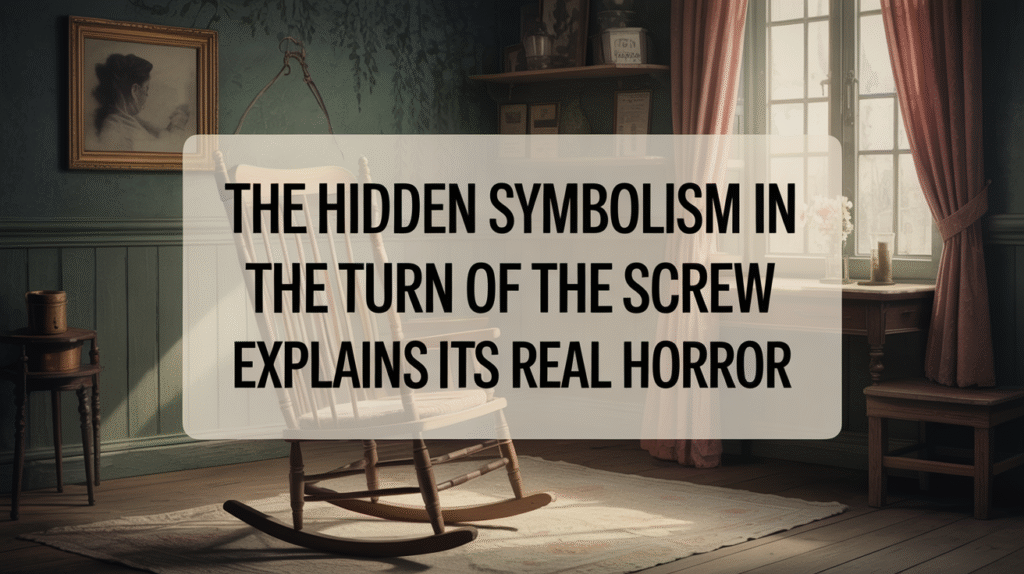The most chilling aspects of “The Turn of the Screw” come not from its ghosts but from the rich symbolism that quietly reshapes our understanding of innocence, power, and fear.

Henry James didn’t rely on jump scares or gore. Instead, he wove symbolic elements throughout The Turn of the Screw, creating a narrative that demands interpretation. Every glance, room, and phrase carries double meanings—this is what elevates the novella from gothic fiction to psychological literature. This article decodes those deeper layers, showing how symbolism unlocks the story’s most disturbing truths.
The Estate – Bly as a Living Symbol
The manor house, Bly, is more than a backdrop—it functions symbolically as both sanctuary and prison.
A Place of Beauty and Isolation
Bly’s physical beauty is constantly described by the governess, but its isolation speaks louder.
- It represents a kind of dream-like illusion that hides underlying rot.
- Its remoteness allows psychological breakdowns and delusions to thrive unchecked.
A Reflection of Mental States
Rooms in Bly often mirror the emotional tension of characters.
- Closed doors and unused rooms reflect hidden secrets and repressed memories.
- The vast yet confining architecture mirrors the governess’s mental entrapment.
The Tower and the Windows – Watching and Being Watched
James repeatedly draws attention to vantage points in the house, using them as metaphors for control and exposure.
Surveillance and Voyeurism
Peter Quint is often seen staring through windows or from the tower.
- These symbols suggest haunting not just by ghosts but by guilt and past traumas.
- The act of watching implies judgment—especially from forces beyond the grave.
The Governess’s Shifting Perspective
Her sightings from windows and towers mark turning points in her delusion.
- She begins to see herself as protector and observer, heightening her sense of responsibility.
- But this role also isolates her further, feeding her obsessive tendencies.
Light and Darkness – Not Just Good vs. Evil
James subverts traditional uses of light and dark imagery to complicate moral judgments.
Shadows and Candles
Light sources in the story are always flickering, uncertain.
- This represents the blurred boundary between good and evil, truth and illusion.
- The use of candlelight suggests fragile insight rather than illuminating clarity.
Darkness as Comfort or Threat
At times, characters seem more comfortable in the dark.
- Flora’s behavior in dim settings suggests secrecy or fear of exposure.
- The governess feels more in control when she is the one holding the light.
Ghosts as Symbols – More Than Just Spirits
Peter Quint and Miss Jessel may or may not be literal ghosts, but their symbolic weight is undeniable.
Personifications of Repression
These figures embody the adult fears and secrets the governess is trying to suppress.
- Quint may represent forbidden sexuality or class transgression.
- Miss Jessel may symbolize shame and the downfall of feminine purity.
Manifestations of Guilt
Their appearances often follow emotional outbursts or rising tension in the governess.
- This timing suggests they might be psychological projections rather than independent beings.
- They serve to push the governess toward increasing irrationality.
Clothing and Appearance – Signals of Identity and Power
James subtly uses clothing to comment on social order, morality, and internal states.
Quint’s Attire
Peter Quint is described as wearing the master’s clothes.
- This inversion of class boundaries alarms the governess, reflecting Victorian anxieties.
- It underscores a symbolic usurpation of authority and propriety.
Miss Jessel’s Black Dress
Her ghost is always seen in mourning wear, even though her death is shrouded in mystery.
- This signifies lingering grief and scandal.
- Her black attire might also point to a loss of innocence and moral fall.
The Children – Innocence or Manipulation?
Flora and Miles are central symbols themselves, used to question the nature of innocence.
Children as Tabula Rasa
They appear angelic but might simply reflect the projections of the adults around them.
- Their behavior is ambiguous, designed to raise suspicion without clear answers.
- They symbolize the battleground between good and evil, real and imagined.
The Governess’s Obsession
Her desire to keep the children “pure” is more symbolic of her own moral struggle.
- She cannot bear the thought of them being corrupted, which heightens her emotional spiral.
- Her control over them symbolizes her fight against chaos.
FAQs About Symbolism in The Turn of the Screw
Here are some questions and answers about symbolism in The Turn of the Screw:
What is the most important symbol in the story?
Bly itself is the central symbol—it reflects both the allure and the psychological danger that define the entire narrative.
Are the ghosts symbolic or real?
They can be read as both. Literally, they may be spirits; symbolically, they represent guilt, fear, and repression.
What do the windows and tower represent?
They symbolize surveillance, vulnerability, and shifting power dynamics between characters.
Why is clothing emphasized in the story?
Clothing symbolizes class, propriety, and transgression—especially in Peter Quint’s and Miss Jessel’s appearances.
What do Flora and Miles symbolize?
They represent childhood innocence under threat, but also serve as mirrors to adult projections and anxieties.
The richness of The Turn of the Screw lies in its layers—and its symbolism is where much of that complexity lives. Every shadow, glance, and whispered phrase adds to the tension, forcing readers to constantly question what they see and what it means. This symbolic depth is what continues to make Henry James’s ghost story a psychological classic.
